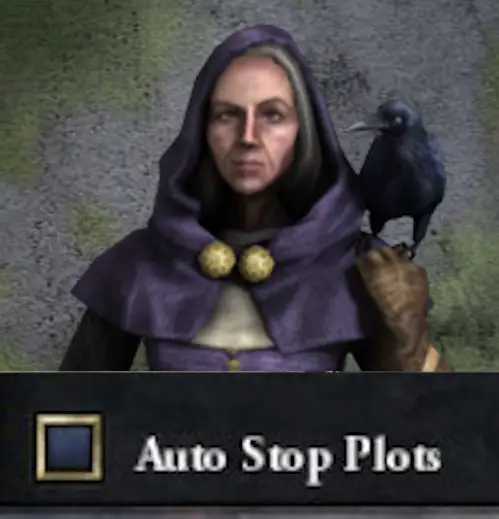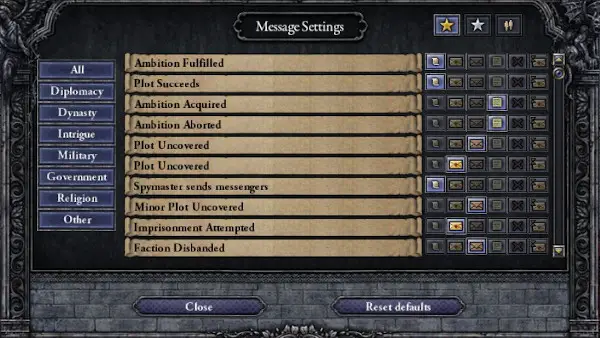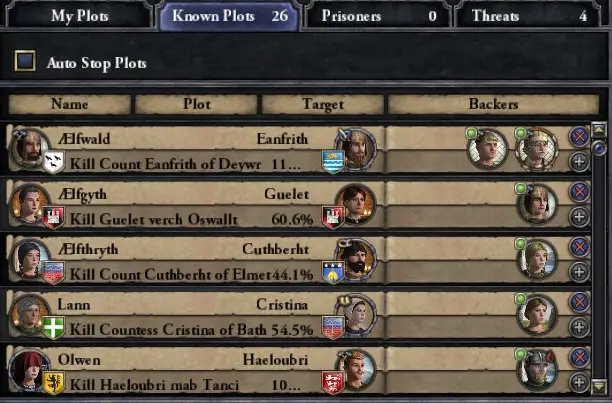Auto-Stop Plots, Let Plotters Plot in Crusader Kings 2

Checking the Auto-Stop Plots box is a neat way to avoid a lot of micro-management in Crusader Kings 2. However it comes with an opportunity cost. Here we will cover 7 reasons why you should leave it unchecked and let plotters plot.
Every character in the game can run their own plots or back the plots of others just as the player character can. Some of these plots may be very injurious to the player’s interests if they succeed and those plots we may well want to stop if we can. However many more plots can be very beneficial.
Checking the auto-stop charges your spymaster with asking all plotters to desist from their known plots. This is regardless of whether those plots are beneficial or not if the plotter acquiesces. On balance probably more beneficial plots are stopped than injurious ones.
So here follows 7 reasons to let them plot.
Eugenics
Often the target of a plot will be someone with negative genetic traits. If the bearer of those traits is allowed to live, marry and breed then those traits can get spread around the realm lowering the quality of vassals and courtiers for generations. Allowing characters to take the initiative in chlorinating the gene pool can have lasting benefits for realm health.
Windfall Inheritances from the Plots of Others
Under many succession laws lieges are heirs of last resort. Thus by allowing characters to keep up a healthy murder rate the occasional title will come your way as the last natural heir is killed off.
Saving you the Trouble of Plotting Yourself
If there is someone you want dead then there is always a chance that someone else does too. Given we are limited to running only one plot of our own at a time having a co-conspirator running parallel plots can be valuable. We can even help them along by backing their plot. While we are limited to authoring only one plot at a time there is no such limit for backing plots.
More than saving a plot slot, parallel plots can save you from the known murderer opinion penalty. And if the target of the plot is a family member it can save you from the kinslayer trait too.
Righteous Imprisonment for Plots
Murderers can be righteously imprisoned. A righteous imprisonment is one for which no one will call you a tyrant. There are many purposes to which prisoners can be put and some are highly situational. The common ones are:
Ransoms, Traitors and Title Revocation
Setting free prisoners for a ransom is a good source of cash as is banishing them. But you have to a make them a prisoner first and it certainly helps if they are actually guilty of something.
If a landed vassal escapes arrest and rebels then he will become a traitor too and so you can have some or all of his titles revoked without a tyranny penalty.
All in all murderers represent a beautiful opportunity to gain gold and land while wearing a halo of righteousness. An opportunity lost if the plotters agree to stop the plot.
Other Purposes for Prisoners
There are other purposes too to which prisoners may be put. Cannibals and Lunatics can eat them though such characters may not care so much for an opinion saving from a righteous imprisonment. If the player’s religion allows for human sacrifice such as the Germanic Blot then a few extra prisoners is all to the good.
Making characters into prisoners for their crimes can also give you hostages to prevent wars and thin out factions.
Better Them Than You
Anyone plotting against someone else is not plotting against yourself. Well they can back a plot of someone else but not start a plot of their own. If you set up your spy master to end plots you are likely just be freeing up the spare time of a plotter to plot against yourself or your own.
It is a sad fact of life in and out of Crusader Kings 2 that the higher you rise in the world the more your enemies multiply. The prevalence of envy and ambition will guarantee as much. The player character, even if only a count or patrician, is a very high profile character among the swarms of barons, bishops, mayors and assorted swarms of lowborns. So it is that any plots against yourself or those you care about can pick up a lot of support relatively easily.
In contrast plots against inconsequential people tend not to pick up much support and so will drag on. The longer those plots grind on the longer the plotter is pre-occupied with his quarry and not with you. It is almost a perverse ideal situation to have all your subjects plotting against nobodies interminably. It is an ideal that cannot co-exist with the auto-stop.
Game Performance
Characters are the primary game element of Crusader Kings 2 and they have a tendency to multiply. Each character will take his share of CPU cycles and memory allocation as the game logic processes their decisions, events and actions. As the world fills up with characters so too the game can lag as system resources approach their limits.
Plagues and wars can thin the herd but the pursuit of personal vendettas can also lighten the load. If you find your system struggling to keep up in the late game you might have another reason to uncheck the auto-stop plots.
Plots on Titles
Not all plots are on someone’s life some are for gaining land titles. It is possible to plot for the lands of vassals, fellow vassals and lieges. Just as with other plot types sometimes the outcomes of these plots will be desirable for the player.
It may happen that a character friendly with the player will plot on the titles of an unfriendly character. Or else a capable vassal would replace an incapable one. In either case the success of the plot may be better for the player’s interests than if it never happened because of the auto-stop.
Counter Arguments
It has to be said for the sake of making a fair case that there are some good reasons for making use of the auto-stop plots. Besides saving some micro-management one powerful case for using auto-stops happens for very large realms in the late game.
The time a plot takes to execute is somewhat proportional to its plot power which in turn is somewhat proportional to the number of backers. In the late game for large realms the potential number of backers can be very large indeed. This can result in plots happening too fast to catch manually. Auto-stop plots is your friend here. Particularly so if you happen to be high up because you or your heirs will likely be the target of a mass plot, as noted above.
Tips and Tricks
Having made the case for leaving off the auto-stops it is only fair to drop some pointers on how to manage plots manually. As the plots accumulate it is important to have a good strategy for handling them.
Decide How to Be Informed
If we want to manually manage plots we must know about them first. There are two ways the player can find out about plots, a passive way and an active way. The passive way is to respond to plot notifications as the game presents them to you. The active way is to periodically survey the Known Plots tab in the Intrigue Screen.
These ways are complementary and both should be used in conjunction with each other. Although play style should influence the emphasis placed on each way.
Set Notifications
Crusader Kings 2 has a highly customisable event notification system. This allows you to fine tune how, and if, events are presented to your attention. You can find the control panel for the event notification system in the main menu under Message Settings.

It is beyond the scope of this article to explore the message settings interface in detail. However we will say there is a tab for Intrigue events such as plots being uncovered and completed. There are also tabs for different classes of characters so that you can have messages of different priority for each. The default settings are quite adequate.
If you combine the message settings with an active use of the Mark Special Interest in Character function you can tailor your notifications to inform you of plots against characters beyond your immediate family whom you care to protect while ignoring all those you do not.
If you set Plot Uncovered messages to the highest priority they will appear as a pop up which pauses the game. This can allow manual plot management to compete with the auto-stop for catching fast late game plots.
Regularly Check Plot Table on Intrigue Screen
Alternatively, or in parallel, all known plots are listed on the Intrigue Screen under the Known Plots tab. The key here is to have a system for sorting through all the plots and a criteria for what to act upon and what to ignore (see Prioritise below for tips on that).

Also we must get into the habit of checking the table on a regular basis especially if we are turning down the priority of messages in the Message Settings. Once a game year is safe enough in the early game.
Prioritise
If you are going to let most plots happen it is important be able to find the few plots we do want to stop or act upon.
Fast Plots
Plots with great plot power will proceed to fruition faster than those with less plot power. Consequently making a decision on these plots should be made with some urgency.
The plot power of plots is shown on the Known Plots tab. However currently there is not a direct way to sort the plot list in order of plot power. However you can sort the list in order of the number of backers by clicking the Backers column header. Since plot power is loosely proportional to the number of backers this can help identify fast plots promptly.
Kin and Heirs
The blood drops and crowns that mark out a character as kin or an heir is visible in the Known Plots tab and Messages as it is elsewhere. Looking out for that symbol as you scan through a list of plots is helpful for identifying plots that require your attention.
Councillors
The crossed hammers on portraits which mark out councillors is also visible in the Known Plots tab. This can help identify when one’s own councillors are in trouble or up to no good. However all councillors will have that symbol, even ones you do not directly employ, so that indicator will tend to generate many false positives. Hovering over the portrait will bring up a tool tip displaying for where the character is a councillor.
Vassals
The more elaborate portrait frames of landed characters are also visible in the Known Plots tab. Looking out for this can help you quickly identify titles which you might righteously revoke after a failed imprisonment. Or where the landed character is the target then you may gain a title from inheritance.